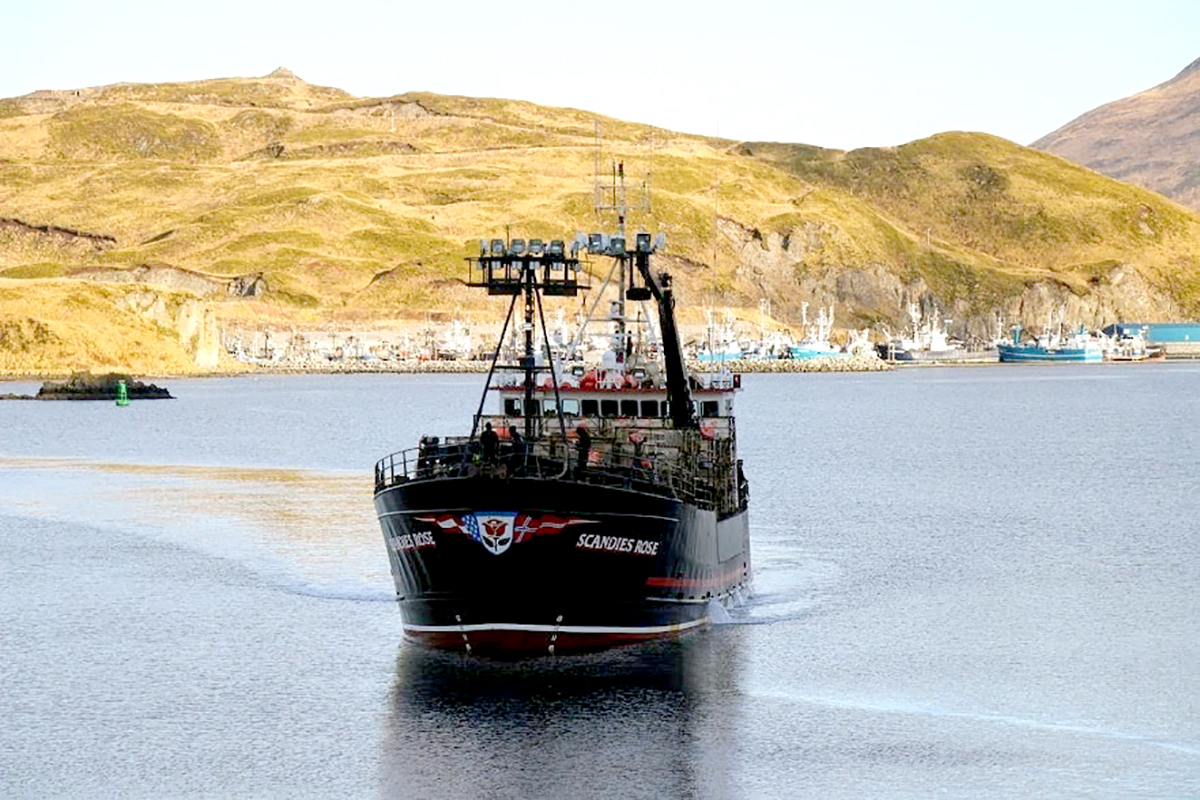“The Scandies Rose was built to last.” Those were the words of longtime marine surveyor Erling Jacobsen, who had inspected the F/V Scandies Rose several times over the last two decades before she was lost to the Bering Sea with five of her seven crew on New Year’s Eve in 2019.
From Feb. 22 to March 5, U.S. Coast Guard and National Transportation Safety Board called for public testimony from witnesses, investors, employees and a range of experts on vessel stability; industry safety; hull modifications and maintenance; and lifesaving practices, protocol and devices.
Those who followed the hearings closely were reminded with each new witness of those lost with the Bering Sea crab and pot-cod boat, as they offered their condolences to the survivors and loved ones of Captain Gary Cobban Jr., David Cobban, Seth Rousseau-Gano, Arthur Ganacias and Brock Rainey.
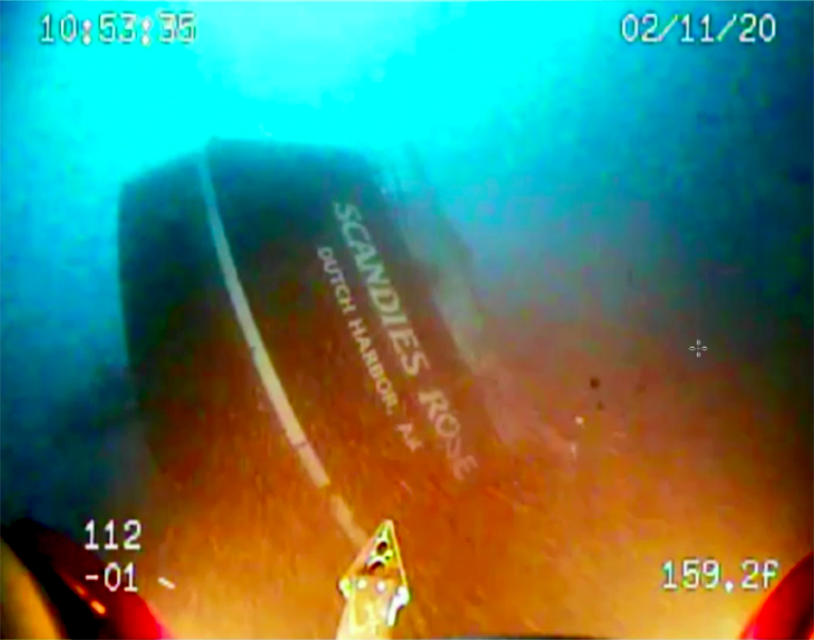
Some of the most memorable moments included the testimony of the accident’s two survivors — deckhands Dean Gribble and Jon Lawler. But the full span of testimony may result in more than one tipping point in regulations, protocol and best practices for Alaska’s winter pot fisheries.
Among the most compelling — and telling — testimony was a panel of naval architects. Paul Zankich, Bud Bronson and Jonathan Parrott, testified together, offering decades of expertise on vessel stability, icing and gear loading.
The panel members referred to the International Maritime Organization’s “shoebox” analogy, which assumes ice collecting on vertical and horizontal surfaces but not inside the webbing of pots stacked on deck because the standards are general and not written specifically for that kind of gear.
“We understand how the IMO came up with the standards they have for icing,” Bronson added. “But the crab fishery in the Northwest Pacific is significantly different than anywhere else.”
Zankich specifically pressed for better data specific to pot gear.
“If you’re a crabber, you have to believe the Coast Guard standards, you have to believe the IMO standards, you have to believe your naval architect,” he said. “All of these three beliefs need review in this inquiry, because we are the naval architects who are asking our owners and operators to believe. And we rely upon the Coast Guard standard to believe and the IMO standard to believe. And honestly, I don’t believe those standards now.”
Regulations account for as much as 6/10 of an inch of ice accumulation on vertical surfaces and 1.3 inches on horizontal surfaces — and uniform accumulation on those surfaces.
“Crab pots… can accumulate ice on the inside of the pots,” said Parrott. “And if you’ve got wind and weather coming from a certain direction, the pots on that side are going to be heavier, are going to accumulate more ice in it than pots on the other side.”
Parrott made the point that better data on pots is critical for the Bering Sea crab fishery, but especially so because pot fisheries are expanding in Alaska as the longline blackcod fishery incorporates pots to protect the catch from sperm whale depredation.
Stability has long been a focus for Alaska’s crab fleet. After the Coast Guard implemented vessel stability and safety checks for the Bering Sea pot fleet in October 1999, fatalities dropped from eight deaths a year in the 1990s to eight deaths over the next five years, according to a report presented by Jennifer Lincoln and Samantha Case, representing the Commercial Fishing Safety Research and Design Program under the National Institute for Occupational Safety and Health.
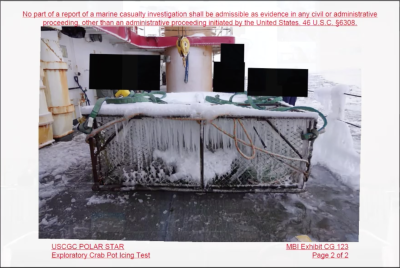
In 2005, managers rationalized the fishery, giving each boat a set quota in place of the derby-style fishery. NIOSH reports just one death in Bering Sea/Aleutian crab from 2005 up until the sinking of the Destination in 2017. The recent losses of the Destination and Scandies Rose — both with reputations of well-maintained boats with experienced captains and crews — have rocked the industry.
“Capsizings like this are associated with the opilio fishery, almost always when the boat has a full load on and is going out for the initial drop,” Chris Woodley, a retired U.S. Coast Guard captain, longstanding safety advocate and now executive director of the Groundfish Forum, told NF.
The Scandies Rose was readying for opilio crab season, but first the crew would fish as much of the Pacific cod pot season as they could squeeze in.
“Are these boats overloaded? If you are using the icing criteria, then what you could carry would probably be a lot less. A boat that could carry 200 pots in non-icing conditions could be, say, 150 in icing conditions,” Woodley told NF. “From an enforcement perspective, the Coast Guard never really crossed that threshold because there are so many other variables.”
The inquiry heard testimony on a wide range of those variables, including loading and stability, weather, fatigue, safety equipment, hull maintenance, and fishing seasons. Lawler testified that they seemed to be in a hurry to get out, and that cod season was possibly why. The over-60 cod boats had had a short season the year before, starting on Jan. 1.
“The year prior to this, their season closed on the sixth of January,” Lawler testified. “They only had enough time to get their gear out in the water, barely make a trip, and then they had to stack out again.”
And this wasn’t just any year. Cobban Jr. knew January 2020 could be the last season of the derby-style cod fishery, before the fishery transition to a proposed individual fishing quota management system, Gribble testified. Those final days of the old fishery would be critical to establish vessel catch history, and in turn future IFQ shares.
“We were already a day or two late, so it was really important for us to get to the grounds,” Gribble told the board.
The added scramble to secure fishing history before rationalization can create unintended consequences in eliminating the race to fish.
Lincoln, Commercial Fishing Safety Research and Design Program director for NIOSH, showed a spike in Bering Sea/Aleutian Islands crab fleet fatalities in the 2004-05 season, the year before the fishery was rationalized, with the loss of the Big Valley in January 2005.
“When creating or modifying fishery management policies, policy makers should consider the potential safety repercussions of those policies and make efforts to enact policies to mitigate these hazards,” Lincoln testified.
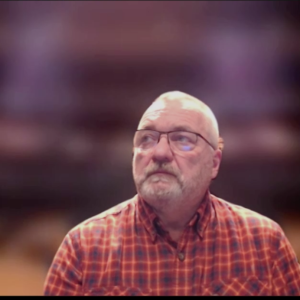
During testimony on Thursday, March 4, Scandies Rose majority owner Dan Mattsen denied that building cod catch was part of their fishing plan but added that Cobban Jr. had autonomy over the vessel as a 30 percent owner.
“Gary had much more experience than I did as a captain,” Mattsen testified. “I would never second-guess Gary’s decision making. I would just trust that he would do the best for himself, for the boat, and for the crew.”
Mattsen’s second round of testimony before the board of investigation on March 4 followed testimony from naval architect Bruce Culver, who completed the last stability report for the Scandies Rose in April 2019.
A naval architect from the Coast Guard’s Marine Safety Center found Culver’s stability report contained “significant errors and omissions,” in particular regarding stability criteria and downflooding points.
Culver, who said he has provided more than 200 stability reports in his 30-year career, defended his work, and Mattsen refused to blame him.
“It’s for other engineers to judge the quality of the work. I’m not throwing Mr. Culver under the bus. I’m a fisherman,” Mattsen said.
However, Mattsen’s prior testimony on the first day of the hearings revealed that he hired Hal Hockema to do the stability test on another of his vessels. Barton Barnum of the NTSB asked why he had hired a different naval architect.
“Excuse my French, but my fucking boat sank,” Mattsen testified. “So I wasn’t going to go back to the same naval architect until we found out what the hell was the cause of that.”
But the ice, the weather and the stability report weren’t the only question marks in the Scandies Rose’s seaworthiness that night.
Though the boat was known for being well maintained, the crew documented a recurring issue with the starboard bycatch chute, which had been repaired twice that year — the second time right before the season after a failed repair at the dock in Seattle, which Mattsen referred to as “a cluster.”

The crew found it was still leaking while they were getting ready for the upcoming season and flagged it for repairs.
“There’s a void underneath [the starboard crab waste disposal chute] from the forepeak to the engine room, and Gary [Cobban] noticed there was water in it,” Mattsen testified. “It turned out to be a crappy weld job. So they had it redone before the winter crab season.”
They hired Highmark Marine Fabrication in Kodiak, where welder Jordan Young did the work. He said the previous fixes on the chute had not rooted out the corrosion.
“They did a doubler, so they didn’t replace the wasted metal, they just put a patch over the top of it,” Young testified, referring to the patch job done in Seattle. “There was significant wasting, and my job was to cut it out, get down to solid metal, and install all new material.”
Kerry Walsh, the project manager for Global Diving and Salvage, led a team that surveyed the wreckage in February 2020.
“Before we left the dock, it was obvious there were questions about the fabrication work that went down prior to the ship sailing,” Walsh testified.
His team sent a Falcon ROV to take images and video of the wreckage, but Walsh said the vessel was on its starboard side, and they could not access the chute.
“There is no obvious reason, no obvious sign why it went down in our eyes,” he said.
Following the welding work in Kodiak, the Scandies Rose crew was set to make its way to Dutch Harbor on Dec. 30, 2019. The trip had begun after three days of nonstop gear work, according to Lawler. They were bustling to switch the pots for the pot-cod season before they moved on to catching opies.
“A typical day on the Scandies was 20 hours. Most days we would run and haul gear for 20 hours and then take a six-hour nap,” testified Cory Fanning, a former engineer on the Scandies Rose. “Gary worked hard. The crew worked. He maybe pushed too hard sometimes. He wanted to be the best at what he did, whatever that was. And maybe at times that didn’t make the crew so happy, but he was an incredible fisherman.”
The fatigue caused by the race to fish is one of the big drivers for quota implementation. Ultimately, crab rationalization reduced disasters significantly, Lincoln testified. However, meeting delivery deadlines to processors (scheduling deliveries avoids a flood of product, but also creates pressure to meet the deadline) and minimizing days at sea to reduce operating costs still leads to long days on deck.
“Rationalization provides the ability to err on the side of safety. Nobody else is going to catch your fish, so that buys you time,” Woodley told NF. “But there are still other operation pressures, which are going to cost you money.”
Lincoln also acknowledged the operating costs of reducing fatigue and noted that the biggest hurdle may be the cultural perception of sleep being a luxury to be bypassed when working hard.
“It would be great to overcome the culture that sleep is for the weak and instead embrace the culture that somehow sleep is a tactical advantage,” she testified.
“We have to manage risk. The more fatigued someone is, the more other safety measures should be put in place,” Lincoln added. “What controls should be put in place around the wheel watch? What controls need to be put in place around gear handling when you’re fatigued?”
In the same presentation, NIOSH epidemiologist Samantha Case testified that weather had been a significant contributing factor in Alaska fishing fatalities. In the Bering Sea, survival depends on getting out of the water quickly, and heavy weather can be the difference between getting in a survival suit or not and then into a life raft or not.
Lawler testified that he thought between the crew being tired after gearwork in Kodiak and the forecast, they’d leave the next day.
“You know we’d been working our asses off getting the boat ready. And then we heard the weather forecast. And I’m thinking, ‘Oh, the boys are gonna have a bar night. We’re gonna go into town and get some beers because we’re definitely not leaving in that.’”
He remembered Cobban Jr. warning the crew about the weather they were heading into and to ensure the gear was secure on deck.
“I knew we were leaving into a storm, and it just didn’t feel right,” Lawler said. “Nothing about it felt right.”
Daniel DeLaurentis, captain of the F/V Ruff & Reddy, had anchored in the lee of an island early the next morning, on Dec. 31, 2019. That evening, a satellite phone call from their company dispatcher alerted them that the Coast Guard was requesting help after hearing a mayday radio call at 10 p.m. from the Scandies Rose, 28 miles away.
DeLaurentis testified that he had to decline.
“I could not travel with a load of gear” in those conditions, he said.
Mike Barcott, attorney for the vessel owners, encouraged the study of the human factors, decision-making that led to vessel loss.
“Let me characterize something I see in these five events — and there may be others,” Barcott said in response to Lincoln and Case’s presentation at the hearings.
“St. George — good captain, good boat, in icing — capsized.
Northwest Mariner — highliner, good captain, icing, capsized.
Lynn J — good captain, good boat, icing, capsized.
Destination — good captain, good boat, icing, capsized.
And now Scandies Rose, by all accounts a very good boat and a very good captain.”
“There has to be some investigation into the pattern of all of them,” Lincoln replied. “And if some of our underlying assumptions aren’t valid, then adjustments should be made.”
Former Coast Guard rescue swimmer and maritime safety expert Mario Vittone testified on the importance of proper safety gear and drills, as well as some possible changes to required safety gear. He noted that flares are practically useless as safety equipment.
“I would trade every flare on my boat for three waterproof flashlights,” he testified.
Vittone advised being sure you have a survival suit that fits and training with your specific raft.
“There is a need to go back and evaluate the usefulness of this gear and how drills are done,” Woodley told NF. “Fishing vessel safety requirements and regulations are pretty darn good. But captains and crews really need to think outside the box and be creative. It isn’t enough to stand around in the wheelhouse and put on a suit. You have to run drills as if an actual emergency is occurring. Your heart needs to be racing — you need to feel pressure. Getting to that level requires more of a cultural change than a regulatory change.”
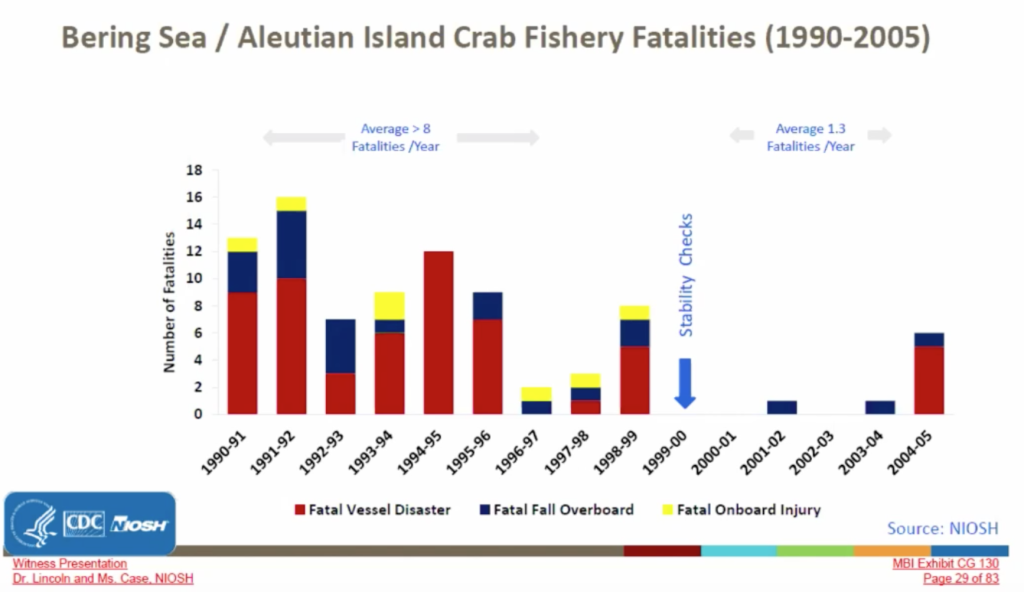
Woodley remembered his time as a safety inspector with the Coast Guard, making changes to drill oversight requirements after the freezer-longliner Galaxy sinking in 2002. The change, he said, dramatically improved drill quality in the fleet.
“What the Coast Guard pays attention to is the stuff the captain is going to prioritize,” Woodley told NF. “So if the Coast Guard comes onboard and wants to see your drills, you’re going to pay attention to that.”
Nothing will ever eliminate the risk of fishing in the dark, cold and isolated waters of the Alaska winter fishery, Lincoln testified.
“It’s crab fishing in the Bering Sea,” testified Bryce Buholm, most recently master of the Western Mariner. “It’s not safe. We do what we’ve got to do.”
Buholm testified the Scandies Rose was the first house-aft vessel to roll over in the fishery. No matter what you do, you’re still fishing in the Bering Sea.
“I call it the freezer hold of hell,” Buholm testified.
Still, the loss of the Scandies Rose was a shock, as was the Destination before it. The conclusion is yet to come. The Coast Guard and NTSB are expected to publish separate reports on the accident and loss, following the testimony and evidence provided in the hearings.
So for now, the fleet is still fishing, waiting for the reports, recommendations and possibly a new slate of regulations aimed at improving safety and outcomes for our fishermen who work some of the harshest grounds in the world.





